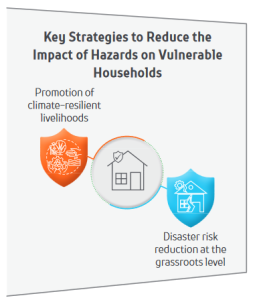LIVELIHOOD
The Enhancing Rural Resilience through Appropriate Development Actions (ERADA) project is implemented in four Indian states as part of the government’s programme to provide sustainable livelihoods for return migrants during the pandemic. One location is Shahbad block in Rajasthan, which has a predominantly rural population with over 50per cent belonging to vulnerable communities, including the indigenous Sahariya tribal community. These communities were heavily dependent on seasonal migration for basic needs and were affected by COVID-19 and loss of income.
MGNREGS is a universal safety net for households in rural India that offers unskilled manual work and generates income during shocks such as weather events or pandemics. It is the largest public employment programme in the world with over 150 million registered households and an annual budget of 7-9 billion US dollars.
The Indo-German project ERADA is a COVID-19 response initiative, implemented by GIZ. The project was designed in response to the return migration from urban to rural areas during the
pandemic. The project strengthens livelihoods of the most vulnerable households in rural areas, aiming to enhance their resilience against future shocks and reducing their dependence on
distress migration.
In the Baran district in south-eastern Rajasthan,the project focused on:
1. Developing a Living Income Benchmark and Accordingly Designing Diversified Livelihood Interventions for the Target Community
Livelihood activities are developed for target communities using the Anker Methodology for Estimating a Living Wage to establish a living income benchmark and calculate the income gap. Accordingly, alternate livelihood activities are developed based on demand, traditional activities, resource availability, market access, and government programmes. Examples include goatery, castor and moringa cultivation, and brick making in Sirohi district, and sesame cultivation, aquaculture, and mushroom production in Gaya district. Climatic factors are also considered, such as promoting goatery as an insurance option during disasters and promoting mushroom cultivation as a climate resilient crop. Most of the activities are planned with the women Self-Help Groups (SHGs) of the National Rural Livelihood Mission (NRLM), also leveraging the financial linkages through NRLM for setting up the enterprises.
2. Using Geographic Information System (GIS) Data for Improving the Work Identification and Strengthening Local Level Planning Processes of MGNREGS, Building Long-term Resilience
MGNREGS follows an annual bottom-up planning process starting at the local government level, where the demand for wage work and the shelf of works are identified. Open-source GIS and digital maps from the Bhuvan platform of the National Remote Sensing Centre in India such as land cover, drainage line treatment maps, etc. are used for identifying more works. This also helped the community and the local government make informed decisions on the works to be selected on priority for better resource utilization and livelihood development in the area. This was useful during the pandemic times when there was high demand for MGNREGS work, that could be met using the additional shelf of works identified through the GIS based planning approach.
Outcomes
- Living income benchmark for ERADA’s project locations including vulnerable households was developed.
- More women and vulnerable households are part of the MGNREGS planning process at the local government level, also using the digital planning approaches.
- Diversified livelihood activities are providing additional incomes to the vulnerable households, improving their nutritional needs and overall standard of living.
- More government programmes are converging for co-financing and establishing integrated interventions.
Learning for SRSP
- Promotion of climate-resilient livelihoods strategies and disaster risk reduction strategies to reduce the impact of hazards on vulnerable households should be key to grassroot level planning processes.

- Inclusive participatory and rights-based
approaches, integrating gender empowerment and transformative approaches can ensure that social protection outcomes are effective and sustainable. - It is required to expand the scope of planning processes and robust follow up and monitoring strategies to ensure desired convergence and constant stakeholder engagement.
- Developing operational partnerships at all levels and across sectors helps grounding the community processes, thereby opening opportunities for knowledge and resource sharing.
- Potential for replication: The model of living income benchmarking for vulnerable households can be replicated and adapted to rural area development in other countries. The approach for enhancing rural resilience through convergent planning and enhancing diversified livelihood opportunities can also be replicated.





